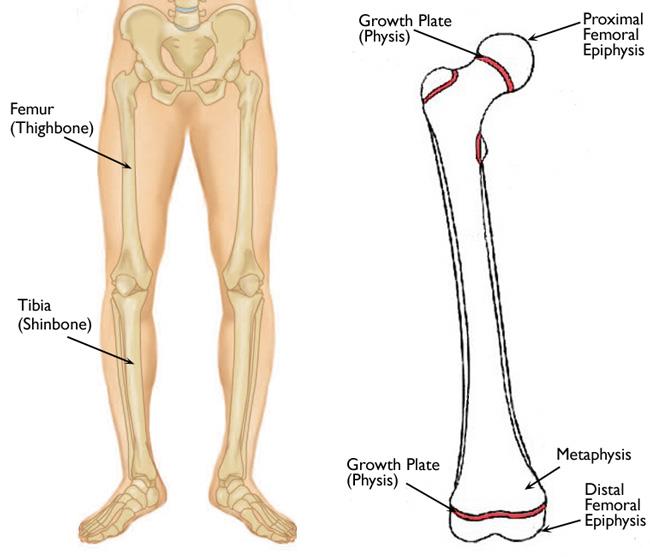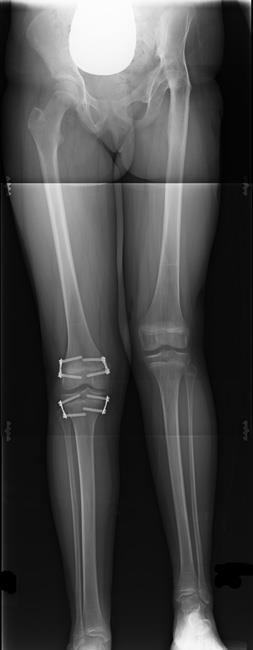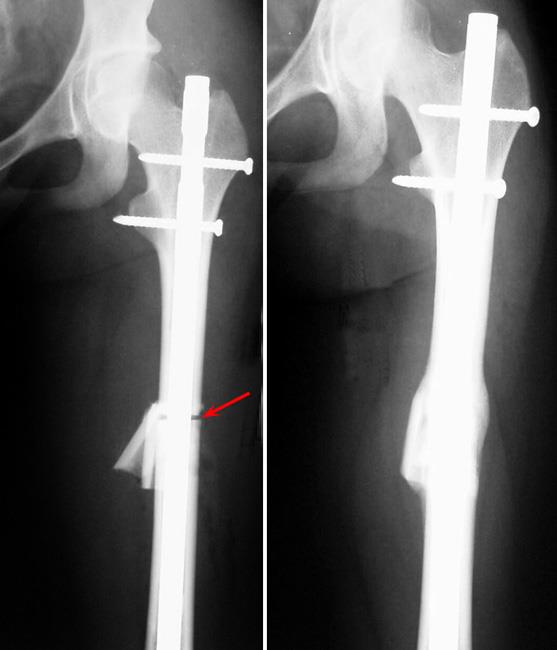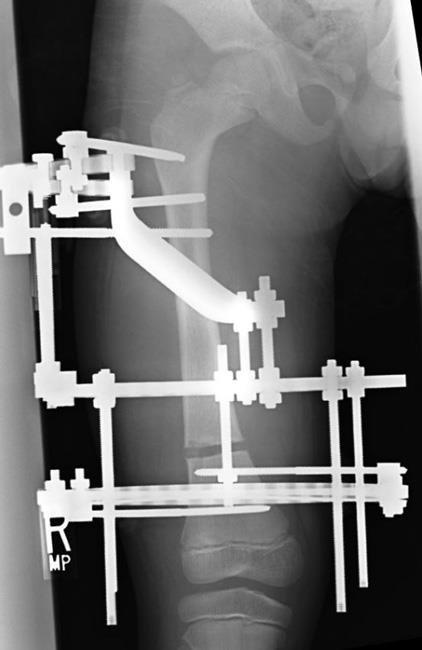Diseases & Conditions
Lower Limb Length Discrepancy
A limb length discrepancy is a difference between the lengths of the arms or legs. This article focuses exclusively on differences in leg length. Differences in arm length are addressed in a separate article: Upper Extremity Limb Length Discrepancy.
Some children are born with legs of different lengths. Sometimes this discrepancy is associated with other congenital malformations. In other cases, an illness or injury may cause a discrepancy in the lower limb lengths to develop over time.
Treatment for a discrepancy depends upon the severity. In many cases, a minor difference in leg length can be well tolerated or evened out by wearing a small lift in one shoe. A child with a more significant difference, however, may benefit from surgery to make their legs the same length. This can be done a number of ways but is most often accomplished through a procedure that slows or stops growth in the longer leg.
Description
More than 50% of people have a subtle difference in their leg lengths. These mild variations usually do not cause problems. However, for the small percentage of people with a leg length difference greater than 2 cm, the difference in length can affect their well-being and quality of life.
In most cases, the bones affected by a leg length discrepancy are the femur (thighbone) and tibia (shinbone).
Like the other long bones in the body, the femur and tibia do not grow from the center outward. Instead, growth occurs around the growth plates. Growth plates are areas of cartilage located between the widened part of the shaft of the bone (the metaphysis) and the end of the bone (the epiphysis).
Cause
If illness or injury affect the growth plate, the bone may grow at a faster or slower rate than the bone on the opposite side.
Previous Trauma to a Bone in the Leg
A broken leg bone can lead to a limb length discrepancy if it heals in a shortened position. This is more likely to happen if the bone was broken in several places. It is also more likely to happen if the skin and muscle tissue around the bone were severely injured and exposed, as occurs in an open fracture. Alternatively, a break in a child's bone through the growth plate can cause permanent damage, which may slow or stop growth in that area, resulting in a shorter leg.
In a child, a broken bone that does not involve the growth plate sometimes will grow faster for several years after healing, causing it to become longer than the bone on the opposite side. This type of overgrowth occurs most often in young children with femur fractures.
Bone Infection
Bone infections that occur in growing children may cause a significant limb length discrepancy. This is especially true if the infection happens in infancy.
Bone Diseases (Dysplasias)
Certain bone diseases may cause limb length discrepancy, such as:
- Neurofibromatosis
- Multiple hereditary exostoses
- Ollier disease
Other Causes
Other causes of limb length discrepancy include:
- Neurologic conditions
- Conditions that cause inflammation of the joints during growth, such as juvenile arthritis
In some cases, the cause of limb length discrepancy is idiopathic, or unknown.
These conditions are usually present at birth, but the limb length difference may be too small to be detected early on. As the child grows, however, the discrepancy increases and becomes more noticeable. In underdevelopment, one of the two bones between the knee and the ankle is abnormally short. The child may also have related foot or knee problems.
Hemihypertrophy (one side too big) and hemiatrophy (one side too small) are rare conditions that cause limb length discrepancy. In patients with these conditions, the arm and leg on one side of the body are either longer or shorter than the arm and leg on the opposite side. There may also be a difference seem between the two sides of the face. In some cases, the exact cause of these conditions cannot be determined.
Symptoms and Signs
The effects of limb length discrepancy vary from patient to patient, depending on the cause and size of the difference. while a slight difference in leg length may not cause any symptoms, a significant difference can cause a noticeable limp and make it difficult for a child to run and play. Sometimes the child will stand with one hip higher than the other or with one knee bent. Other children will toe walk on their shorter leg. Because these differences require the child to exert more effort to walk, they may tire easily.
Some studies suggest that patients with lower limb length discrepancies are more likely to experience low back pain and are more susceptible to injury. Other studies do not support this finding, however.
Doctor Examination
Parents are usually the first to detect a lower limb length discrepancy when they notice a problem with the way their child walks. Discrepancies are also sometimes detected when a child undergoes a screening at school for curvature of the spine (scoliosis).
Your child's doctor will conduct a thorough physical examination and use tests to confirm or diagnose a discrepancy in length, as outlined below.
Physical Examination
During the exam, your doctor will ask about your child's general health, medical history, and symptoms. They will then perform a careful examination, observing how your child sits, stands, and moves.
Gait analysis. During the examination, your doctor will closely observe your child's gait (the way they walk). Young children may compensate for a lower limb length discrepancy by flexing their knee or walking on their toes.
Measuring the discrepancy. In most cases, the doctor will measure the discrepancy when your child is standing barefoot. They will place a series of measured wooden blocks under the short leg until the hips are level, and thus determine the discrepancy. Sometimes, an X-ray is taken with the wooden blocks in place to assess whether the pelvis is truly level. This can also determine whether any spinal curature responds to correction of the discrepancy with the wooden blocks.
Imaging Studies
X-rays. An X-ray provides images of dense structures, such as bone. If your doctor needs a more precise measurement of the discrepancy, they may order X-rays of your child's legs.
Scanograms. This is a special type of X-ray that uses a series of three images (hips, knees, and ankles) and a ruler to measure the length of the bones in the legs. Your doctor may order a scanogram instead of, or in addition to, a traditional X-ray.
Computerized tomography (CT) scans. These studies can provide a more detailed image of bone and soft tissue in the legs than X-rays; however, they create a greater exposure to radiation for your child. In some complex cases, your doctor may use a CT scan to measure the limb length discrepancy.
If your child is still growing, your doctor will likely repeat the physical examination and imaging studies every 6 to 12 months to see if the discrepancy has increased or remained the same.
Treatment
Your doctor will consider several things when planning your child's treatment, including:
- The size of the lower limb length discrepancy
- Your child's age (and how much growth they have remaining)
- The cause of the discrepancy, if known
- Any underlying neurologic issues
Nonsurgical Treatment
For patients with minor limb length discrepancies (less than 2 cm) and no angular deformity, treatment is usually nonsurgical. Because the risks of surgery may outweigh the benefits, surgical treatment to equalize small differences in leg length is not usually recommended.
For patients with an underlying neurologic disorder, it may actually be beneficial for their weaker leg to be slightly shorter than the stronger leg. This allows the child to better clear the weaker leg when they swing it through during walking.
Nonsurgical treatments may include:
Observation. If your child has not yet reached skeletal maturity, and the discrepancy is less than 2 cm, your child's doctor may recommend simple observation until your child's growth is complete. During this time, your child will be re-evaluated at regular intervals to determine whether the discrepancy is increasing or remaining the same.
Wearing a shoe lift. Your child's doctor may suggest a lift, fitted to the inside or outside of the shoe, to see if it imprves your child's ability to walk and run. A shoe lift may also help with back pain caused by a smaller lower limb length discrepancy. Shoe lifts are inexpensive and can be removed easily if they are not effective.
Surgical Treatment
In general, surgeries for lower limb length discrepancy are designed to do one of the following:
- Slow down or stop the growth of the longer limb
- Shorten the longer limb
- Lengthen the shorter limb
Epiphysiodesis
In children who are still growing, epiphysiodesis can be used to slow down or stop growth at one or two growth plates in the longer leg. The advantage of this minor surgical procedure is that it does not require cutting the bone or prolonged limitation in weight bearing for the child. The child, however, must still be skeletally immature (growth plates open) so that their remaining growth in the normal leg can be used to equalize their leg lengths.
Epiphysiodesis is a relatively simple surgical procedure that can be performed in one of two ways:
- The surgeon may drill or scrape the growth plate to stop further growth. The limb length discrepancy will gradually lessen as the opposite leg continues to grow and catch up.
- The surgeon may place metal staples, or a metal plate with screws, around the sides of the growth plate to slow or stop growth. These metal implants are then removed once the shorter leg has caught up.
The procedure is performed through very small incisions in the knee area, using X-rays for guidance. Proper timing is critical. The goal is to reach equal leg length by the time growth normally ends — at age 14 for girls and 16 for boys, on average, though this often varies. Doctors make decisions about timing based on known averages, with the use of growth charts.
The decision on whether to perform this procedure on the femur, tibia, or both depends on the location of the discrepancy. This is assessed so that leg lengths can be equalized and the knee heights of each leg are nearly symmetric at maturity.
Disadvantages of epiphysiodesis include:
- The possibility of a slight over- or under-correction of the lower limb length discrepancy
- The patient's adult height will be slightly less than it normally would have been
Lower Limb Shortening
In patients who are finished growing, the longer limb can sometimes be shortened to even out the leg lengths.
To do this, the doctor removes a section of bone from the middle of the longer limb, then inserts metal plates and screws or a rod to hold the bone in place while it heals.
Because a major shortening may weaken the muscles of the leg, limb shortening cannot be used for very large lower limb length discrepancies. In the femur, a maximum of 3 inches can be shortened. In the tibia, a maximum of 2 inches can be shortened.
Lower Limb Lengthening
Because of their complexity, lower limb lengthening procedures are usually reserved for patients with very large discrepancies in length.
Lengthening can be performed either externally or internally.
External lengthening. In this procedure, the doctor cuts the bone of the shorter leg into two segments, then surgically applies an external fixator to the leg. The external fixator is a scaffold-like frame that sits outside the leg and is connected to the bone with wires, pins, or both.
The lengthening process begins approximately 5 to 10 days after surgery and is performed manually. The patient or a family member turns the dial on the fixator several times each day.
When the bones are gradually pulled apart (distracted), new bone will grow and fill in the space created. Muscles, skin, and other soft tissues will adapt as the limb slowly lengthens.
The bone may lengthen 1 mm per day, or approximately 1 inch per month.
Lengthening may be slower in a bone that was previously injured. It may also be slower if the leg was previously operated on. Bones in patients with potential blood vessel abnormalities, such as cigarette smokers, may also need to be lengthened more slowly.
The external fixator is worn until the bone is strong enough to support the patient safely. This usually takes about 3 months for each inch of growth. Factors such as age, health, smoking, and participation in rehabilitation can affect the amount of time needed.
External limb lengthening requires:
- Meticulous cleaning of the area around the pins and wires
- Diligent adjustment of the frame several times daily
Potential risks and complications of external lengthening include:
- Infection at the site of wires and pins
- Stiffness of the joints immediately above and below the bone being lengthened
- Slight over- or under-correction of the bone's length
- Failure of the bone to consolidate into strong new bone
Internal lengthening. In this procedure, the doctor cuts the bone in the shorter leg, then surgically implants an expandable metal rod in the bone. The rod is completely internal and lengthens gradually in response to the normal movements of the patient's limb, or to an external magnetic motor.
As the rod lengthens, the bones are gradually pulled apart, and new bone grows in the space created. The rod provides stability and alignment to the bone as it lengthens.
Because no external fixator is used in internal lengthening, there is less risk of infection — including the superficial infection that commonly occurs around pin sites.
Both internal and external lengthening take several months to complete. Both procedures require:
- Regular follow-up visits to the doctor's office
- Extensive rehabilitation, including physical therapy and home exercise
A doctor experienced in lower limb lengthening techniques will talk with you about your treatment options and explain the risks and benefits of both internal and external lower limb lengthening. Together, you and your child's doctor will decide which procedure, if any, is best for your child.
Last Reviewed
September 2021
AAOS does not endorse any treatments, procedures, products, or physicians referenced herein. This information is provided as an educational service and is not intended to serve as medical advice. Anyone seeking specific orthopaedic advice or assistance should consult his or her orthopaedic surgeon, or locate one in your area through the AAOS Find an Orthopaedist program on this website.












